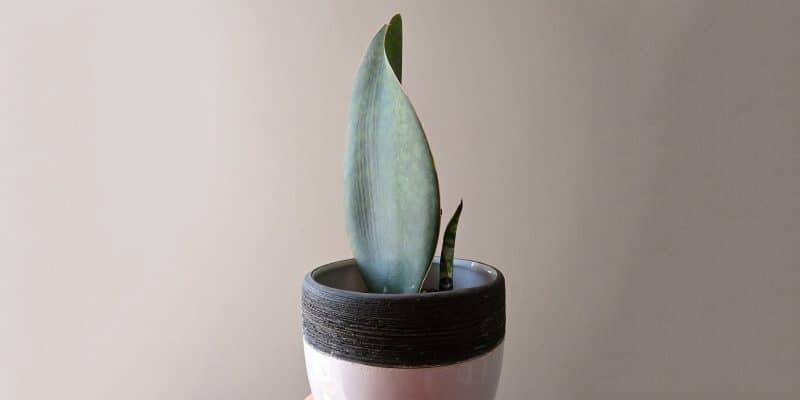Having a whale fin plant is kind of like accenting your decor with a graceful whale majestically gliding through the ocean. It’s got broad, splendid fins . . . I mean, leaves . . . that make an effortless statement in your living space.
Known for its cetacean appearance and low-maintenance temperament, the whale fin plant is the perfect addition to your flourishing plant family.
So, without further ado, dive in with us as we explore the alluring depths of whale fin plant care. We hope you have a whale of a time!
Table of Contents
Whale Fin Snake Plant Care Guide
History, Habitat, and Characteristics
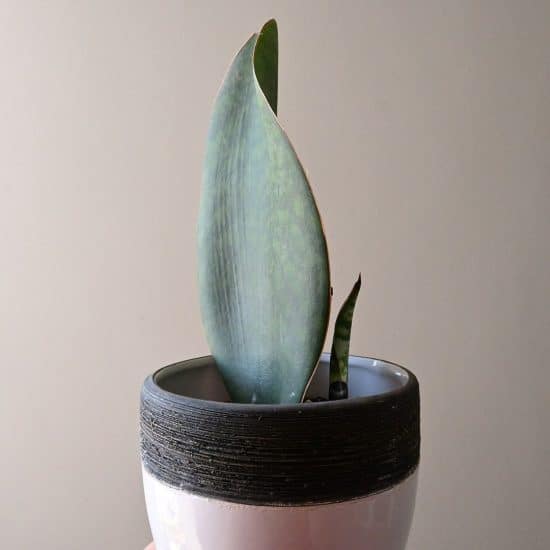
First, let’s address the whale in the room. The whale fin plant used to be Sansevieria masoniana. That’s right — the whale fin is one of many snake plant varieties. But it’s now Dracaena masoniana. This change has to do with molecular discoveries from around 2018 that led to the Sansevieria genus now being classified as Dracaena.
If you’re still with us after that fascinating explanation of taxonomy, great! The whale fin plant has quite the story to tell. It hails from the Democratic Republic of Congo in Africa, where it loves basking in warm and humid tropical environments near the equator.
You might also hear the whale fin snake plant referred to as Mason’s Congo or shark fin plant. The most iconic characteristic of this stunning plant is its broad, paddle-shaped leaves. These magnificent leaves can reach up to 4 feet in length and as many as 12 inches wide.
The whale fin plant sports an enchanting array of colors that make it stand out from the crowd. Its leaves are speckled with dark to light green hues, sometimes even showing off silver or yellow variegation. This colorful foliage is sure to catch the eye and spice up any indoor space.
Light
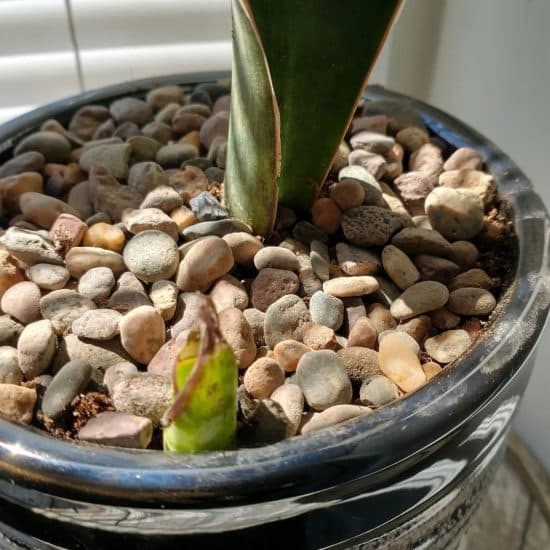
This adaptable snake plant variety can withstand a range of light conditions, from lower light areas to bright, filtered light for about 4 to 6 hours daily. The more light it gets, the faster it will grow. Just remember, direct sunlight can harm your whale fin snake plant.
If your whale fin sansevieria/dracaena isn’t basking in enough light, you might notice it growing slowly or becoming leggy as it reaches out for a better light source. On the flip side, if it’s bathing in too much direct sunlight, the leaves could end up sunburned and discolored, sporting unsightly brown spots.
This plant will flourish in an east- or north-facing window, but a west- or south-facing window might be too much for whale fins unless the light is filtered or dappled from a curtain or an outside tree.
Our lighting tips:
- Place your whale fin in a spot with 4 to 6 hours of bright, indirect light daily.
- Although it can tolerate lower light, your whale fin snake plant will thrive and produce offsets more effectively when given plenty of bright, indirect light.
- Use a sheer curtain or scoot your whale fin sansevieria a bit further from a window to keep the light bright but indirect.
Water
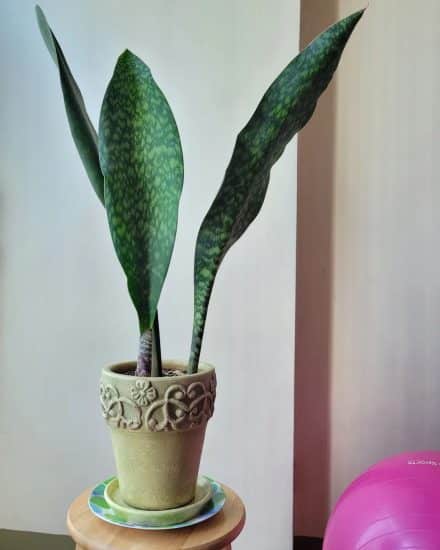
Like most succulents, whale fins hold water in their leaves and don’t need frequent watering from you. Water only when the soil is completely dry.
Overwatering can lead to yellowing leaves, mushy stems, and soil that seems to never dry out. Your whale fin’s leaves may even flop over like a collapsed dorsal fin. If you spot these signs, it’s best to hold your horses and let the soil dry out completely — and then some — before watering again.
On the other hand, if your whale fin is parched, its leaves will begin to shrivel and feel soft to the touch. The plant may start to droop, signaling that it’s high time to increase the watering frequency. If you feel the soil and it’s bone dry or compacted, you’ve waited too long. Gradually reintroduce water and move it to some shade.
Our watering tips:
- Be mindful of your whale fin’s light exposure; the brighter the location, the more water it may need.
- To test the soil moisture, simply stick your finger a couple of inches into the soil. If it’s totally dry, go ahead and quench your snake plant’s thirst!
- Always use a pot with drainage to avoid standing water.
Temperature and Humidity
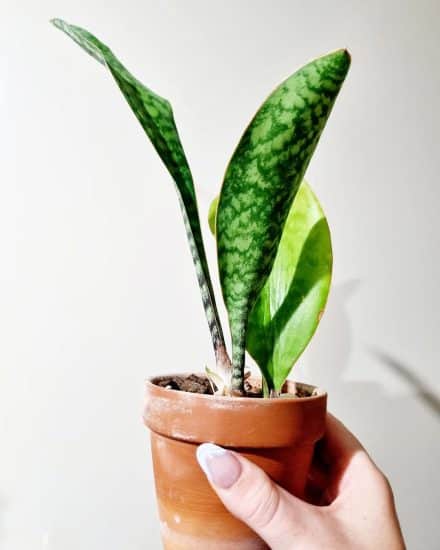
Taking care of your whale fin snake plant means keeping an eye on both temperature and humidity requirements.
Whale fin snake plants feel right at home in a warm temperature range of 60-85°F (15-29°C). Keep in mind, though, that they’re frost-tender plants — so be sure to bring your green friend indoors in winter! To avoid any chilly mishaps, place your plant far from drafts or cold windows during the winter months.
But what if things get too hot to handle? If you notice wilting or drooping leaves in a warm room, it’s time to cool things down a bit.
The whale fin snake plant isn’t too picky when it comes to humidity. No need for additional misting or precise humidity control. Still, it’s a good idea to keep an eye on your home’s humidity to ensure your plant remains cozy.
If your whale fin snake plant shows signs of excessive humidity (think mold or mildew), it’s time to dial back the moisture. On the other hand, brown leaf tips or a struggling plant might call for a humidity boost.
Despite not requiring regular misting, a little spritz now and then can help remove dust and potential pests from your plant’s leaves. If you do mist your whale fin sansevieria, give the leaves a gentle wipe afterward.
Soil and Planting
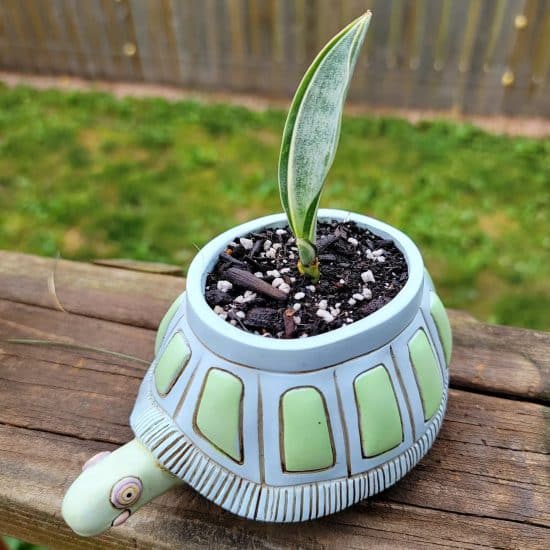
Snake plants in general like to be root bound, so don’t go repotting your whale fin right away. When you do, though, a succulent and cactus mix is the way to go. For a winning soil mixture, try Miracle-Gro Cactus Potting Mix combined with perlite for added aeration, and aim for a neutral soil pH.
Terracotta pots are a stellar choice, since they help wick away excess moisture from the soil, protecting your whale fin snake plant from rot. A plastic pot with plenty of drainage would probably be fine, too, but avoid ceramic, which can retain too much moisture.
Keep in mind that pots with built-in saucers are a no-no for this moisture-sensitive plant. When choosing a pot, make sure it’s not too big. Oversized pots can lead to overwatering. And drainage holes, regardless of pot material, are nonnegotiable with snake plants.
Fertilizing
Fertilizing snake plants isn’t strictly necessary. They aren’t heavy feeders because their native soil is rather nutrient-poor. But if you want to encourage offsets (mini plants!), you can fertilize once a month with a 1/4-strength liquid houseplant fertilizer.
Beware of over-fertilizing, though! If you notice yellowing leaves or stunted growth, you might need to dial it back. To counteract over-fertilization, give the soil a good flush with water and cut back on feeding.
Propagation Guide
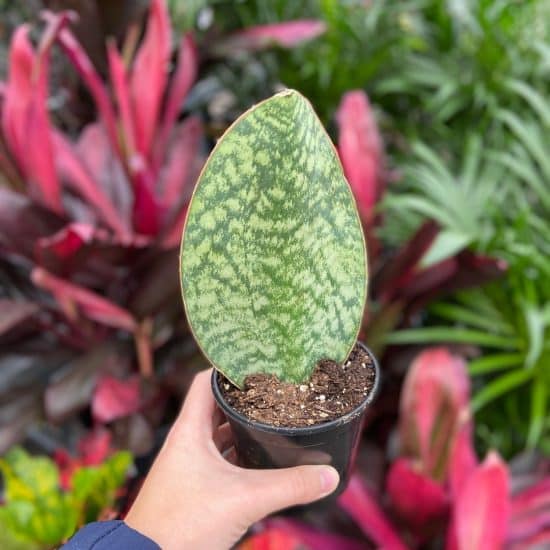
There are two methods of propagating your whale fin: rhizome division and leaf cuttings. Both are easier than they sound!
Propagate whale fin via rhizome division:
- Gently loosen up your whale fin snake plant from its pot and give the dirt a shake to expose the rhizomes. They’ll look like underground stems.
- Carefully separate the little offsets connected to the rhizomes, making sure they’ve already grown some roots. Be gentle — you don’t want to hurt the new roots while separating the offsets. After all, they’re the future of your parent plant!
- Pot the separated plants in individual pots filled with a well-draining potting mix. Give the new plants a light watering to welcome them to their new homes.
Propagate whale fin via leaf cuttings:
- Pick a winner by choosing a healthy leaf on your whale fin. Grab a disinfected, sharp tool, and make a clean cut near the base of the leaf. A clean cut makes for a happy plant!
- Let it breathe by allowing the cut end of the single leaf to dry for a day or two. This helps avoid any unwanted rot when you plant the leaf.
- Insert the leaf’s cut end into a pot filled with well-drained potting mix, heavy on perlite, light on soil, to keep from rotting the leaf.
- Find the sweet spot by placing the pot in a warm, bright area with indirect sun. Be patient — it may take weeks to see new leaf growth sprout.
Pro tip: For best results, propagate in spring and early summer.
Common Issues
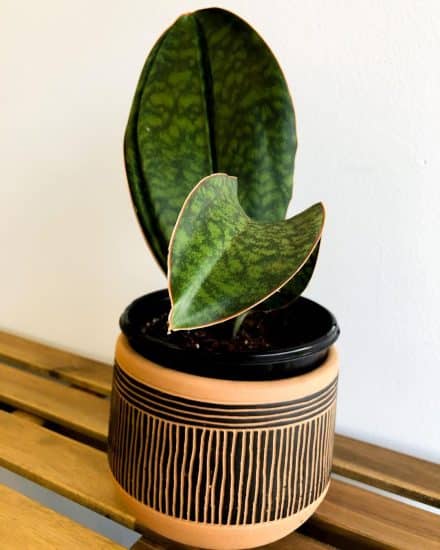
Dry, Falling Leaves
Whale fin plants can be a bit finicky, and their leaves may dry out and fall off, especially if the plant has been on the move or soaking up too much direct sun. Trim away those sad, dead parts without cutting into the live green tissue. Then, find a better spot for your whale fin snake plant with indirect sunlight.
Another culprit of dry leaves could be underwatering. If your plant’s leaves are falling off and they feel dry and brittle, it’s probably thirsty. The trick is to not let it be dry for too long. And remember — the more sun it gets, the more water it needs.
Curling Leaves
Now, let’s talk about curling leaves – they’re pretty common for whale fin plants, and they usually scream, “I need water!” (though not literally. That would be scary). Spotting curling leaves is easy — just look for single leaves rolling up or down along their length.
Most of the time, they’re simply dehydrated because they haven’t been getting enough H2O. To turn things around, make sure you water your whale fin plant when the soil feels dry. Those leaves will start to perk up!
However, if you’re sure you’ve been giving your plant enough water and those leaves are still curling, it might be a case of overwatering. Too much water can cause issues like root rot and even plant death. To avoid this calamity, water sparingly, use a gritty soil mix, and make sure your pot has plenty of drainage!
Pests and Diseases
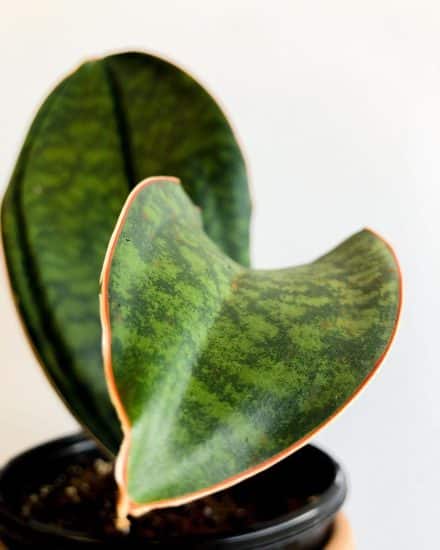
Mealybugs and Spider Mites
Mealybugs and spider mites are pretty common for snake plants, but we can show them the door together. Mealybugs look like tiny cotton balls hanging around on your plant’s leaves and stems. Spider mites, on the other hand, are a bit harder to spot — they’re tiny red or brown bugs that spin delicate webs around the leaves.
Regularly inspect your whale fin snake plant for cotton-like fluff or webbing on the leaves and stems. Can’t see the spider mites? Try using a magnifying glass, or even your camera zoom for a closer investigation. If you do spot any of these pests, they’re pretty easy to get rid of.
First things first, separate the affected snake plant from your other plants to stop these pests from spreading. Then, grab a spray bottle filled with water to blast them off, or use a cloth dipped in isopropyl alcohol to gently wipe those leaves and stems. If the pests are stubborn, try using insecticidal soap or neem oil.
Prevention is key: Check on your whale fin snake plant regularly and use a damp cloth to clean its leaves — this helps keep the plant less attractive to bugs. Ensure you’ve got good ventilation and don’t overcrowd your plants.
Root Rot
Root rot — the bane of all indoor plant enthusiasts! Many houseplants, including your precious whale fin, can fall victim to this often terminal disease. It usually happens when we love our plants a little too much and overwater them. The soil gets too soggy and the roots start to suffocate . . . not a pretty picture.
Be on the lookout for yellowing, wilting leaves and a not-so-pleasant smell coming from the soil. If you take the snake plant out of its pot and see black, mushy, slimy roots, you’ve got root rot.
To rescue your whale fin snake plant, gently remove it from the pot, and, using sterilized scissors, trim away those sickly roots. Discard the old soil, give the pot a good cleaning, then repot the plant in fresh, well-draining soil. Don’t forget to add in some drainage materials like perlite, pumice, or LECA to let those roots breathe.
Preventing a repeat: To keep root rot at bay, wait to water your whale fin plant until the top few inches of soil have dried out. Make sure that the pot has proper drainage holes and avoid letting the plant sit in standing water.
Conclusion
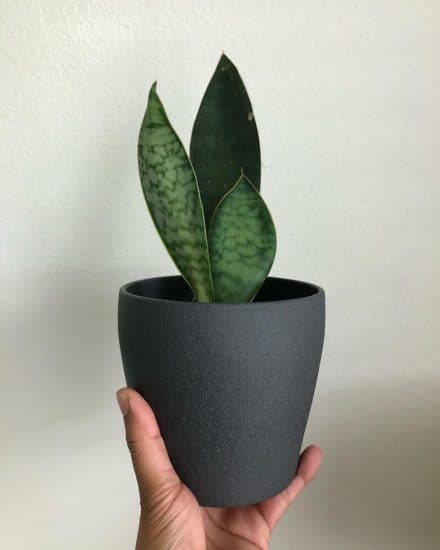
That’s it for our whale fin plant care guide! Now you’re well-equipped with the knowledge and tools to help your Dracaena masoniana thrive and steal the spotlight in your indoor garden.
Whale fin plant care summary:
- This adaptable plant can tolerate a range of lighting conditions, but it flourishes best in bright, indirect sunlight for 4 to 6 hours daily.
- Avoid overwatering or underwatering to ensure a healthy plant.
- Proper drainage and well-aerated soil are essential for avoiding the dreaded root rot.
- Temperature and humidity requirements are not demanding, but don’t overdo it one way or the other.
With this comprehensive guide at your side, you’ll soon become a whale fin plant expert, ready to nurture and enjoy this stunning addition to your indoor plant collection. We hope this guide was helpful, and don’t hesitate to reach out if you have any further questions. Happy growing!
FAQ
Are whale fin plants rare?
Whale fin plants might not be the most common variety of snake plant in your local nursery, but they’re actually not rare. If you can’t find one at your local garden center, they’re pretty easy to find online.
Why are whale fin plants expensive?
Their combination of beauty and resilience has made them quite popular among plant enthusiasts, driving up the demand and, subsequently, the price. Prices have started to come down, but a slow grower like whale fin can take a bit to propagate, so it’s taken time for supply to catch up.
How big do whale fin plants get?
On average, these remarkable plants can reach heights up to 3 to 4 feet, with their leaves expanding anywhere from 6 to 10 inches in width.
How fast do whale fin plants grow?
Pretty slowly. While the whale fin is, in general, a slow-growing plant, their growth rate will depend on factors such as lighting, watering, and overall care.
Is whale fin a Sansevieria or Dracaena?
The Whale fin sansevieria plant is actually a part of the Dracaena genus. Previously, all snake plants belonged to the Sansevieria genus, but a recent reclassification in the botanical world has grouped whale fin sansevieria — and all snake plants — as Dracaena. Trust that either name, whale fin sansevieria or whale fin dracaena, refers to the same plant.
As such, whale fin sansevieria care is the same as whale fin dracaena care.

